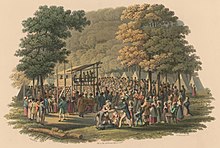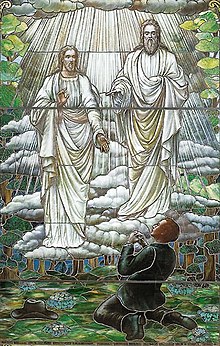Early life of Joseph Smith
By 1817, Smith's family had moved to the "burned-over district" of western New York, an area repeatedly swept by religious revivals during the Second Great Awakening.
Smith family members held divergent views about organized religion, believed in visions and prophecies, and engaged in certain folk religious practices typical of the era.
In 1823, Smith said an angel directed him to a nearby hill where he said was buried a book of golden plates containing a Christian history of ancient American civilizations.
Smith carried the Y-DNA marker R-M222, a subclade of Haplogroup R1b found almost entirely in people of Northwestern Irish descent today.
After he sold the family farm to pay his debts, the Smiths "crossed the boundary dividing independent ownership from tenancy and day labor."
"[4] Then during the winter of 1812–1813, typhoid fever struck along the Connecticut Valley, including the area around Lebanon, New Hampshire, where the Smiths had recently moved.
After the typically horrific early nineteenth-century surgery without either anesthetic or antiseptic, Smith eventually recovered, though he used crutches for several years and had a slight limp for the remainder of his life.
[5][6] In 1814 the Smiths moved back across the Connecticut River to Norwich, Vermont, where they suffered three seasons of crop failures, the last the result of the Year Without a Summer.
[8] In Palmyra village, Smith Sr. and his oldest sons hired themselves out as common laborers, ran a "cake and beer shop," and peddled refreshments from a cart; Lucy painted cloth coverings for tables and stands.
[22] Biographer Fawn Brodie wrote, "He was a gregarious, cheerful, imaginative youth, born to leadership, but hampered by meager education and grinding poverty.
New York west of the Catskill and Adirondack Mountains became known as the "Burned-over district" because it was "repeatedly singed by the fires of revival that swept through the region in the early years of the nineteenth century.
These visions confirmed in his mind the correctness of his refusal to join any organized church and led him to believe that he would be directed in the proper path toward salvation.
[33] Lucy's account, recorded thirty years after the period in which the visions are said to have occurred, suggests "a tendency to make her husband the predecessor of her son" by echoing passages in the Book of Mormon.
[34] Like perhaps thousands of contemporary Americans,[35] the Smith family practiced various forms of folk magic such as using divining rods and seer stones to search for buried treasure.
"[36] Magical parchments handed down in the Hyrum Smith family may have belonged to Joseph Sr.[37] Lucy Mack Smith noted in her memoirs that while family members were "trying to win the faculty of Abrac, drawing magic circles or sooth saying," they did not neglect manual labor, "but whilst we worked with our hands we endeavored to remember the service of & the welfare of our souls.
"[38] Smith's reputation among his Palmyra neighbors was that of a "nondescript farm boy" who was "lazy and superstitious," and townspeople viewed his family as "treasure-seekers, not eager Christians.
"[39] Thus, Smith was reared in a family that believed in prophecy and visions, was skeptical of organized religion, and was interested in both folk magic and new religious ideas.
[59] In an account Smith dictated in 1838 for inclusion in the official church history, he described the First Vision as an appearance of two divine personages sometime during the spring of 1820: "I saw a pillar of light exactly over my head, above the brightness of the sun, which descended gradually until it fell upon me...When the light rested upon me I saw two Personages, whose brightness and glory defy all description, standing above me in the air.
[61] According to Smith, he told his mother at the time that he had "learned for [him]self that Presbyterianism is not true";[62] however, mention of this conversation is omitted from Lucy's own history,[63] and Joseph never stated that he described the details of the vision to his family in 1820 or soon thereafter.
The bulk of Smith's persecution seems to have arisen among laity, and not because of his First Vision, but because of his later assertion to have discovered the golden plates in a hill near his home;[citation needed] the statement was widely publicized and ridiculed in local newspapers beginning around 1827.
"[73] In late 1825, Josiah Stowell, a well-to-do farmer from South Bainbridge, Chenango County, New York, who had been searching for a lost Spanish mine near Harmony Township, Susquehanna County, Pennsylvania with another seer, traveled to Manchester to hire Smith "on account of having heard that he possessed certain keys, by which he could discern things invisible to the natural eye.
[83] While Smith was working as a treasure hunter, he was also frequently occupied with another more religious matter: acquiring a set of golden plates he said were deposited, along with other artifacts, in a prominent hill near his home.
[87] Thus, on September 22, 1823, a day listed in local almanacs as the autumn equinox, Smith said that he went to a prominent hill near his home, and found the location of the artifacts.
According to an account by Willard Chase, the angel gave Smith a strict set of "commandments" which he was to follow in order to obtain the plates.
[104] Leaving Emma in the wagon, where she knelt in prayer,[98] he reportedly walked to the site of the golden plates, retrieved them, and hid them in a fallen tree-top on or near the hill.
[102] Over the next few days, Smith took a well-digging job in nearby Macedon to obtain money to buy a solid lockable chest in which he said he would put the plates.
[108] When Emma heard of this, she went to Macedon and informed Smith Jr., who reportedly determined through his Urim and Thummim that the plates were safe, but nevertheless he hurriedly traveled home by horseback.
[107] Later, he said he took the plates out of the chest, left the empty chest under the floor boards, and hid the plates in a barrel of flax, not long before the location of the empty box was discovered and the place ransacked by Smith's former treasure-seeking associates, who had enlisted one of the men's sisters to find that location by looking in her seer stone.
[98] When Lucy visited Harris, he had heard about Smith's report to have found golden plates through the grapevine in Palmyra, and was interested in finding out more.
[122][better source needed] The money provided by Harris was enough to pay all of Smith's debts in Palmyra, and for him to travel with Emma and all of their belongings to Harmony Township, Susquehanna County, Pennsylvania.






